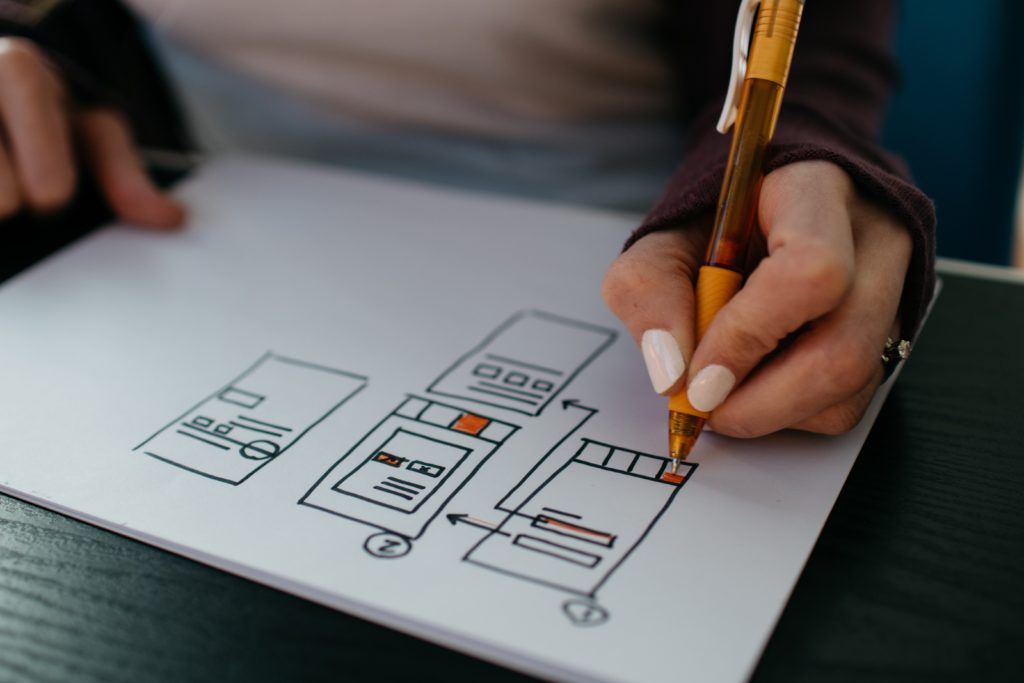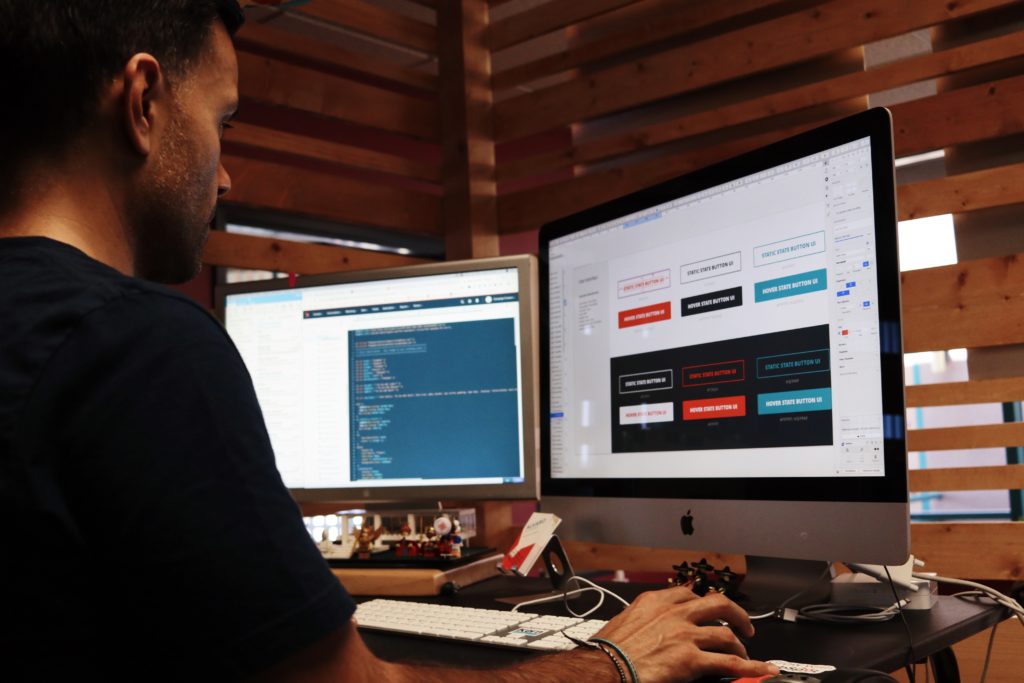Welcome to our 100 ft. view into our process from the moment we first talk with a prospect to the launch of their website. Our process is painstakingly outlined in a flowchart (see video above) that outlines every step including any client actions, client meetings, email communications, and client approvals.
As a person who loves a good process, there’s something really comforting about knowing that there will be a predictable outcome if I follow a set number of steps.
I’ve refined this process over the 18 years that I’ve been in business. This is the process that works for me and is built on a solid foundation of training and education. I want to be transparent about my process so my clients know what to expect as we work together.
At Thrive, we’re not cowboy coders or designers flying by the seat of our pants. We have a plan and we’re going to stick to it. And this plan will enable us to deliver fantastic, reliable results every time.

A potential client finds a way to get in touch. It could be an email. It could be a referral. It could be through a contact form on our website. It could be by carrier pigeon. Whatever method they choose, they find a way to let us know they have a web development project they need to tackle.
The very first thing we do is schedule an intake call. This call allows us to discover some very important details about this project:
In this call, I'm also trying to figure out if the potential client and I would work well together and if this project is a good fit. Other important considerations are whether their budget matches their expectations and will they respect the process I’ve honed through the years.
This initial interview will not only help us figure out the project parameters but also what product will best serve their needs: the full Thrive treatment or a fixed monthly website solution. The second option is for clients that are more budget-conscious or they need a website that will position them well online and nothing more. No marketing run, no branding.
For clients that need a more custom solution, something larger and more bespoke, Thrive can make that happen. Maybe it’s an e-commerce site. Maybe it’s a membership-only site. Maybe they have a lot of components that need to fit together. Maybe they need a lot of marketing around their site. Thrive is for the company that needs a big web solution.
If this is the case, we schedule more conversations. Some really deep conversations to understand more about what needs to be done. I’ve seen a lot of projects fail because they don't go through a robust strategy session and I don’t want that fate to befall my clients.

I give my clients homework.
No, really. I’m a big fan of avoiding meetings that could have been an email. It saves time and money for everyone involved. So before we schedule our two, deep-dive meetings and before establishing a development, marketing, creation plan, I ask that the client fill out an intake form to better give me an idea of what their needs, expectations, and requirements are. This way we can spend our two deep-dive meetings really digging into the meat of the project, and not establishing parameters. It also lets me know if our marketing and branding teams need to be involved.
At the end of this step, we know what this project is going to cost, how long it's going to take, and the scope of the project. We send the final proposal to the client and, if they agree and send the deposit, we move to step 3.

Welcome to Thrive! It’s in this step that you become an official client of Thrive. We even send you a fancy welcome packet with all the information you need to ensure this is a smooth process, including educational pieces on how to get content to us and graphics. On our end, we set up all the administrative framework we need to keep everything organized on trackable, including time tracking, password storage, and all that good stuff.
As part of this organizational process, we begin to figure out what pages your website is going to need and develop a sitemap. If there is a marketing piece to this project and an SEO plan needs to be made, then we call Cliff. Cliff is our SEO guru. Cliff knows how to get websites found. He’ll join us for a sitemap meeting to ensure that everything is optimized to perfection.
We'll summarize all of these decisions in an email, create that sitemap, and email our client to get their feedback and approval.
This step is also where we will mock up any logo that’s required and start the marketing and branding plan creation if the client needs it. But sometimes the client is working with another third party on branding and sometimes the branding is already set.
Related reading: SEO Seattle

Let’s start the design! Now that we have an approved sitemap, we can dig into the meat of the design and development phase beginning with the homepage design. In the beginning, we only use Lorem Ipsum (or placeholder) text so the client can really focus on the design elements.
After meeting with the client to review the design, we give them access to one of our favorite tools: Project Huddle. This software actually shows the clients what their revisions would look like. They can see their feedback visually, giving them a better idea of what they are asking for. We’ll make those changes and submit it to the client for review. Normally, our projects only go through one or two rounds of feedback before the client signs off.
Once the homepage is completed, we then move on to the sub-page design. The process is very much the same as for the homepage. We use placeholder text and the client signs off on all design decisions before we finalize our design.
And now you have a website with a logo, a sitemap, AND incredible design. And it’s only step 4!
(As for the payment schedule, once we complete step 4, a payment of 40% is required before we continue.)

Now we tackle the content and another decision needs to be made. Who is writing and inputting the copy on the website?
If they're writing and inputting the content themselves, we train them on how to edit the content of their website, which is actually very easy to do. We conduct this training over video and provide our clients with a copy so they can train other staff members on how to update their website’s content.
If they’re writing the content themselves but don’t want to input it, we're happy to do it, provided they get us all the copy at once. We still provide training on how to edit their website content because they will be responsible for any future updates.
If they have a copywriter or they're using our copywriter, the copywriter and client work together to develop all the copy needed to fill out the website. This could be done through interviews or reviewing existing content.
Once the content is finalized and inputted, it’s time to take the site live.
Related reading: Copywriting seattle

Well…It’s almost time to take the site live. We have a whole pre-launch checklist to run through before making the site publically available. It’s like the fifteen minutes before a shuttle launch where Mission Control makes sure everything is prepped and ready but for your website.
We test to make sure your website is mobile-friendly. We make sure your website loads quickly. We double-check that all the information is correct.
And then, BAM!, your website is released into the world.
Once we go live, we do a final training session with the client over a video screen share. That training is recorded and sent to them so they can train additional staff. This is when the final 10% payment of the project is due and our 30 day, no questions asked warranty starts.
Our last two client meetings happen 30- and 90-days post-launch. These meetings are to make sure everything is going smoothly; that the client isn’t having any trouble updating the site; and to see how the new site has impacted their business. We love to hear the success stories of our clients after their launch day!
So that’s my process and, I’ve got to say, I love it. I love how this process has helped countless businesses improve their web presence. I love how this process enables me to really outline what clients can expect when they work with us. I love how this process ensures a great result every time. If you have any questions about my process, please let me know in the comments. If you’re a client and want to share about your experience, I’d love to hear from you!
—
Thrive Design is a customer-centric web design agency from Seattle. Contact us today to find out how we can elevate your business online! Find us on Clutch, UpCity, LinkedIn, Facebook, and Twitter.
Category: Web design seattle
